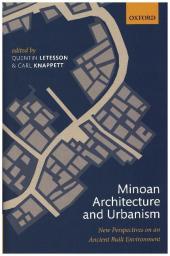 Neuerscheinungen 2017Stand: 2020-02-01 |
Schnellsuche
ISBN/Stichwort/Autor
|
Herderstraße 10
10625 Berlin
Tel.: 030 315 714 16
Fax 030 315 714 14
info@buchspektrum.de |

Carl Knappett, Quentin Letesson
(Beteiligte)
Minoan Architecture and Urbanism
New Perspectives on an Ancient Built Environment
Herausgegeben von Letesson, Quentin; Knappett, Carl
2017. 416 S. 240 mm
Verlag/Jahr: OXFORD UNIVERSITY PRESS 2017
ISBN: 0-19-879362-6 (0198793626)
Neue ISBN: 978-0-19-879362-5 (9780198793625)
Preis und Lieferzeit: Bitte klicken
Nearly 4,000 years ago some of the very earliest towns of Europe appeared on the Mediterranean island of Crete. In this book we offer new insights into these ancient palaces and towns, as a contribution to a broader understanding of the diverse ways in which humans have made and used ancient built environments.
Minoan Crete is rightly famous for its idiosyncratic architecture, as well as its palaces and towns such as Knossos, Malia, Gournia, and Palaikastro. Indeed, these are often described as the first urban settlements of Bronze Age Europe. However, we still know relatively little about the dynamics of these early urban centres. How did they work? What role did the palaces have in their towns, and the towns in their landscapes?
It might seem that with such richly documented architectural remains these questions would have been answered long ago. Yet, analysis has mostly found itself confined to building materials and techniques, basic formal descriptions, and functional evaluations. Critical evaluation of these data as constituting a dynamic built environment has thus been slow in coming.
This volume aims to provide a first step in this direction. It brings together international scholars whose research focuses on Minoan architecture and urbanism as well as on theory and methods in spatial analyses. By combining methodological contributions with detailed case studies across the different scales of buildings, settlements and regions, the volume proposes a new analytical and interpretive framework for addressing the complex dynamics of the Minoan built environment.
This edited volume is an interesting and inspiring read for everyone interested in architectural studies. Especially the introductory chapters to each part written by the editors (chapters 2, 6 and 11) are stimulating, while the first and final chapter (chapters 1, 15) provide ample reference to earlier studies of various architectural (Minoan) features. Corien Wiersma, Journal of Greek Archeology


